ginew/iStock/GettyImages
Think of Cornish hens, which are a cross between White Rock and Cornish chickens, as miniature chickens. These small, tasty birds are often reserved for the elegant dinner party, while chicken is accessible enough for a weeknight meal. You might have a harder time finding Cornish hens and you'll almost certainly pay a higher price per pound.
Small, Medium and Big
The main difference between a Cornish hen and a chicken is the mature size of the bird. Cornish hens rarely weigh much more than 2 pounds, while chickens can weigh double that. Fryers or broilers, which are commonly found in the grocery store, weigh in at around 3 1/2 to 4 pounds, while a roasting chicken weighs close to 5 pounds. On the farm, Cornish hens reach maturity faster than chickens -- in only about 28 days. Broiler and frying chickens are butchered between 39 and 42 days, while a roaster's lifespan is 50 days.
It's in the Packaging
Another difference between Cornish hens and chickens lies in how they're packaged. You'll probably never see Cornish hens sold in any way other than whole. Chickens, on the other hand, are packaged in numerous ways. You can buy whole chickens or packages of boneless, skinless chicken breasts or thighs, drumsticks or a whole chicken cut into pieces. Both frozen and fresh chickens are widely available, but you might have a tough time finding fresh Cornish hens because they're often sold frozen.
Get Cooking
Another difference between Cornish hens and chickens lies in how they're cooked. Because of their size, chickens can be cooked in myriad ways -- roasted whole, stuffed, cut up and fried or cubed and tossed in stir-fries and casseroles. Boning Cornish hens isn't really practical because they're so small. Besides, they're the perfect size for an individual serving and look charming on a plate. Roast or grill Cornish hens whole or split them in half. You can also stuff them, but be careful because the thin skin tears easily. Slather Cornish hens with fruit preserves or other marinades to keep the meat moist.
Safe Cooking
Like chickens, Cornish hens may carry bacteria that can cause foodborne illness. Wash your hands, cutting boards and knives with warm, soapy water after handling either one. Roast Cornish hens and chickens at temperatures between 325 and 400 F for 40 to 50 minutes, depending on the preparation method. Halved Cornish hens cook more quickly than whole birds and stuffed birds need the most time of all. The hens are done when a meat thermometer inserted in the bird reads 165 F. Cover any leftovers and store them within two hours of serving in a fridge set at 40 F. Use the leftovers within three days.
Related Articles
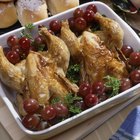
How to Cook a Cornish Game Hen in a ...

How to Cook Calamari in the Oven
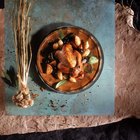
The Best Way to Cook Cornish Hens

How Long Do You Need to Boil Large ...
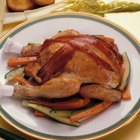
How to Grill a Cornish Hen on the ...
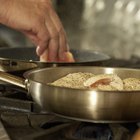
Can I Cook Chicken That's Been Thawed ...

How to Defrost a Chicken in a ...
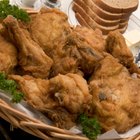
How to Par-Cook Chicken Before Frying

How to Cook Poussin in an Oven

Difference Between Fryer & Roaster ...

How Fast Does Cooked Spaghetti Squash ...

How to Roast Cornish Hens With Potatoes ...

Can You Roast Whole Frying Chickens?

How to Cook Prawns in a Oven

How to Boil Celery

How Long to Cook Parboiled Potatoes
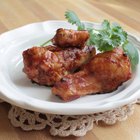
How to Bake Frozen & Prebreaded Chicken
How to Grill Chayote Squash

Can You Bake Wonton Wrappers Instead of ...
How Long to Bake Split Cornish Hens
References
Writer Bio
Julie Christensen is a food writer, caterer, and mom-chef. She's the creator of MarmaladeMom.org, dedicated to family fun and delicious food, and released a book titled "More Than Pot Roast: Fast, Fresh Slow Cooker Recipes."